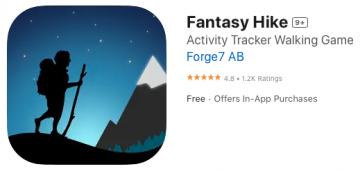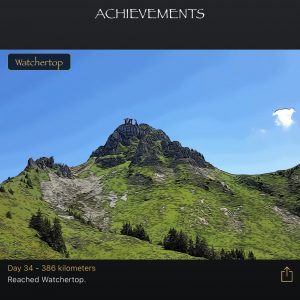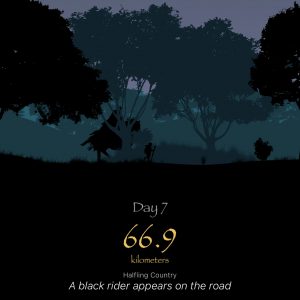
For my final project, I wanted to take a deeper look at passing-off implications for fandom creations. Specifically, the implications for a new app that is based almost exclusively upon the journey that Frodo Baggins took in the Lord of the Rings (“LOTR”) series.
On December 28, 2023 I stepped out my virtual hill house in “Halfling Country” and began the 2,865 km journey to “Mount Fire”. I had downloaded the app Fantasy Hike, which is a walking tracker designed to encourage people to get more daily steps by challenging themselves to race their friends and virtual competitor(s) on a journey to Mount Fire (Apple App Store: Fantasy Hike).

The app makes numerous quirky references to the LOTR series, while strategically avoiding places and character names that I assumed were protected under trademark, for example: the “Shire” is instead called “Halfling Country”; “Mordor” or “Mount Doom” is always “Mount Fire”; the “Prancing Pony” is the “Strutting Pony”;“Weathertop” is “Watchertop”, and “Rivendell” is “Riverdale”. Additionally, if Mr. Underhill is too fast for you to keep up (he walks an aggressive average of 13km per day for over seven months), you may elect a different seemingly trademark-friendly competitor, such as “Jon Snowflake”, “Alice Wonderfoot”, and “Harryfoot Potter”.
My virtual journey is far from over; however, I have already noticed that while the app has cleverly changed some of the more renown places and names, others names are exactly the same as the series. Why is it that the app can still reference “Black Riders”, why is the “Brandywine River” still the “Brandywine River”, and why is Frodo’s alias of “Mr. Underhill” kept as “Mr. Underhill” in the app?
According to the Tolkien Estate, a legal body that oversees and manages the estate of J.R.R. Tolkien, “many characters, places, events and other elements from The Hobbit and The Lord of the Rings…are trademarked by the Saul Zaentz Company (Tolkien Estate Website). After some personal research, I confirmed that the LOTR series is indeed protected under copyright (Canadian Copyright Database), and that many LOTR character and location names are protected under trademark (Canadian Trademarks Database: Frodo Baggins). I also discovered that many of the classic LOTR trademarks previously owned by The Saul Zaentz Company, per the Tolkien Estate, are now listed as “Dead” or “Abandoned”, and most of these trademarks are now listed as “Active” under MiddleEarth Enterprises, LLC (United States Trademark Patent and Office: Baggins).
The very long list of “Active” trademark LOTR names includes “Prancing Pony”, “Frodo Baggins”, “The Shire”, “Rivendell”, “Gollum”, “Tom Bombadil”, etc. Regardless of who owns these LOTR trademarks, it is clear that many LOTR character and location names are protected by “Active” trademarks. However, I found that many other well-known LOTR names are not, and have never been protected under trademark. These unprotected names include: “Mr. Underhill”, “Black Riders”, “Brandywine River”, “Last Bridge”, etc.
In examining the character and location names that Fantasy Hike adapted (EX: “Old Tom”), I found myself wondering if the creators had taken sufficient measures to avoid potential trademark and passing-off allegations, given that the app’s characters and “plot” still display a notable likeness to the LOTR series.
Passing-off is a common law tort that protects against the deceptive use of trademarks, trade names, or other distinguishing get-ups that may confuse customers into believing that goods or services of one company are associated or authorized by the company with trademark protection (s.7 Trademark Act).
Per, BCAA et al v. Office and Professional Employees’ Int Union et al 2001 BCSC 156, there are two broad categories of passing-off, first in situations where competitors in a common field of activity where one uses names, packaging, and product descriptions in a way likely to lead the public to believe that their product or business is that of their competitor with trademark protection, the second is in situations where a competitor promotes their product or business in a way to create a false impression that their product or business is in some way approved, authorized, or endorsed by their competitor with the trademark.
Here, there is no common field of activity and the names used in Fantasy Hike are so bizarre that true LOTR fans (the members of the public most likely to purchase the app) would immediately know that the app was not sanctioned by the LOTR franchise. However, per Mattel Inc. v. 38947207 Canada Inc. 2006 SCC 22, the test person for trademarks involving less expensive products is typically a “casual consumer somewhat in a hurry”, and it is possible that an ordinary person in a rush may mistake Fantasy Hike as being authorized or endorsed by the LOTR series.
There are three necessary components to passing-off: the existence of goodwill; public deception due to a misrepresentation; and actual or potential damage to the plaintiff.
The LOTR series clearly has goodwill, as evidenced by the fact that the first novel was published in 1954, the first movie was released in 2001, and the franchise is estimated to have made over $10-15 billion (Yahoo Finance: How Much Money has ‘The Lord of the Rings’ made?). Furthermore, there may be an element of deception as, while a true LOTR fan would instantly recognize that the app is not associated with the LOTR trademark, an ordinary hurried shopper may not realize. However, per Institut national des appellations d’origine des vins et eaux-de-vie et al v. Andres Wines Ltd et al(1987) 60 OR (2d) 316, misrepresentation in passing-off requires that such misrepresentations be calculated and intended to deceive the public to the detriment of the goodwill of the trademark holder. Here, it’s doubtful that this potential deception was calculated with an intent to deceive the public and harm the LOTR trademark owner. Fantasy Hike, like most fandom creations, was likely created in homage to a celebrated and beloved franchise.
Based on the available facts, it seems dubious that an intent to misrepresent could be proven, especially as the creators took steps to modify names and clearly took the time and effort to determine exactly which names were trademark protected, and which were not. However, if deception could be made out, it’s unlikely that actual or potential damage to the LOTR trademarks owner could. The LOTR franchise earns revenue through officially licenced merchandise, movies, books, videogames, etc. A walking app is not a competitor to the franchise and is unlikely to cause potential or actual damage to their brand, their sales, nor their goodwill.
Using character and location names that have been slightly modified away from trademarked names could potentially qualify as passing-off, especially if the modified names are similar enough to the trademarked names to cause confusion. However, while fandom creations like Fantasy Hike may cause some trademark confusion, these fandom creators should be able to avoid passing-off allegations, particularly if they take steps to minimize confusion and don’t cause any actual or potential damage to the trademark owners.






 Communications Law
Communications Law
This great post reminds of something I saw during the COVID lockdown times. During COVID many running events and marathons were postponed or cancelled to avoid gathering in large numbers. At that time, I noticed there were “virtual marathon” apps that were doing something similar to what Fantasy Hike does. An example would be the app Conqueror where you sign up for a challenge run and the app tracks your distance. When you complete the challenge you receive a rather elaborate medal in the mail.
Unlike Fantasy Hike, Conqueror has formed partnerships with a number of brands including with the Lord of the Rings. They advertise you can “[w]alk, run or cycle all the way from The Shire to Mount Doom in an epic adventure with one goal – destroying the One Ring.” The medals sent for these LOTR challenges are decorated with the iconography of the particular challenge (e.g., the Eye of Sauron Medal has a giant Eye of Sauron on the front and Galadriel’s mirror on the back).
Conqueror is obviously trying tap into the large fandom of LOTR who may also find a running challenge app interesting. But unlike Fantasy Hike, they were willing to provide consideration for the use of the IP as oppose to take the effort to try to be somewhat suggestive of LOTR while avoiding passing-off like in the case of Fantasy Hike.
For more information: https://www.theconqueror.events/lotr8/
Thank you for the great post! It is very interesting to compare the IP protection method of Tolkien Estate with Hoyoverse’s in Celine’s post. Obviously all of these are part of the IP protection repertoire. Both sides want to avoid costly infringement lawsuits, so learning pre-emptive measures that both sides can deploy is really useful!
In class we talked about the length of protection of IP rights is 70 years plus the lifetime of the author. Tolkien died in 1973, which means that the protection of his copyrights ends in 2043. I am on the critical side about why the protection extends so long after the author passes away. Meanwhile, If the rooftop rescue scene in zombie movies can be a genre, why can’t the genre of the medieval fantasy be more broad too?
I agree with your analysis that fandom creators should be able to avoid passing-off allegations. I personally think that on the issue of fandom creations, the interpretation about deception and the damage should be interpreted more strictly to allow more room for derivative works. It could be beneficial to the author and their estate, because it could potentially generate more profits and keep the literature live and relevant for a longer period (think about Star Trek fan productions). Why give big production exclusive rights to make mediocre things and ban genuine fans who are creating something that contributes to the goodwill of the original work? Feels a little shortsighted. Also, Things like Hoyoverse’s statement might help to set a benchmark to keep a balance between the commercial value and goodwill of the IP and a free marketplace of art and creativity which could eventually feed back into a greater audience, and marketshare for the official franchise.